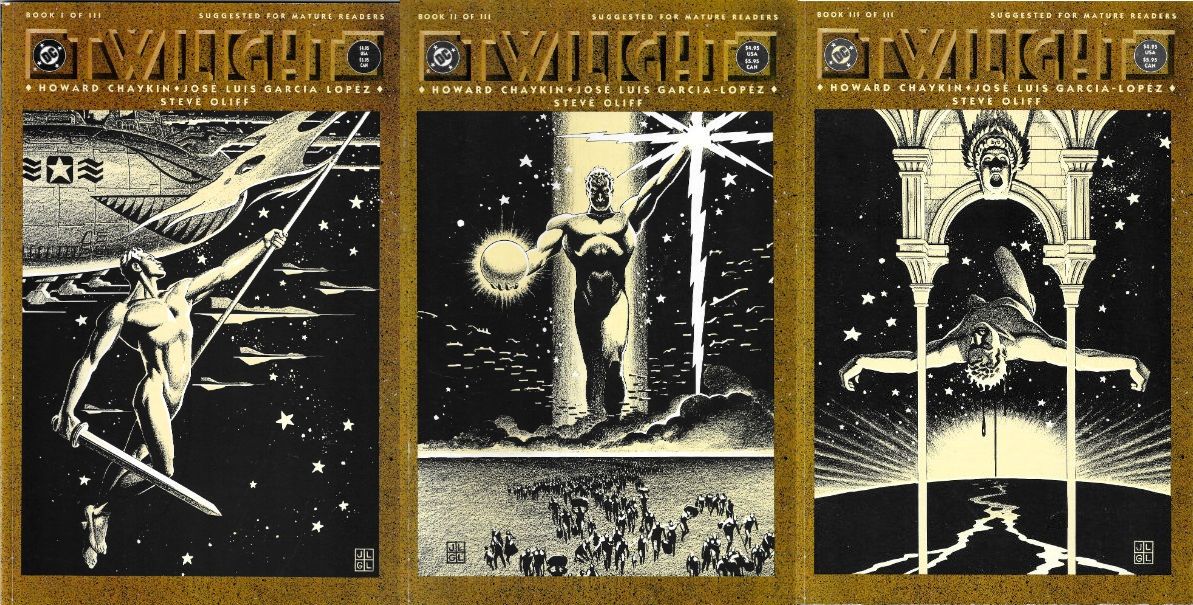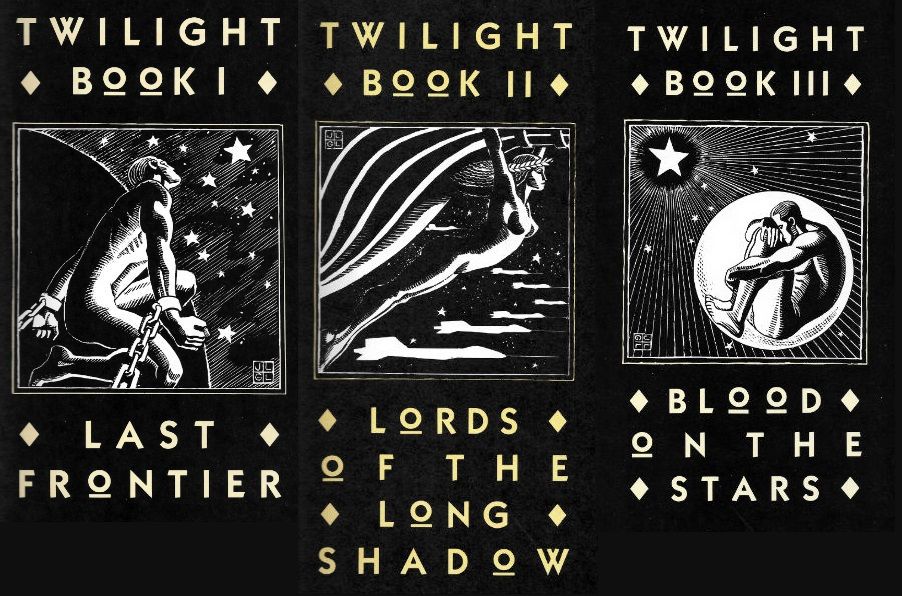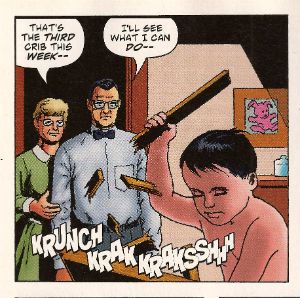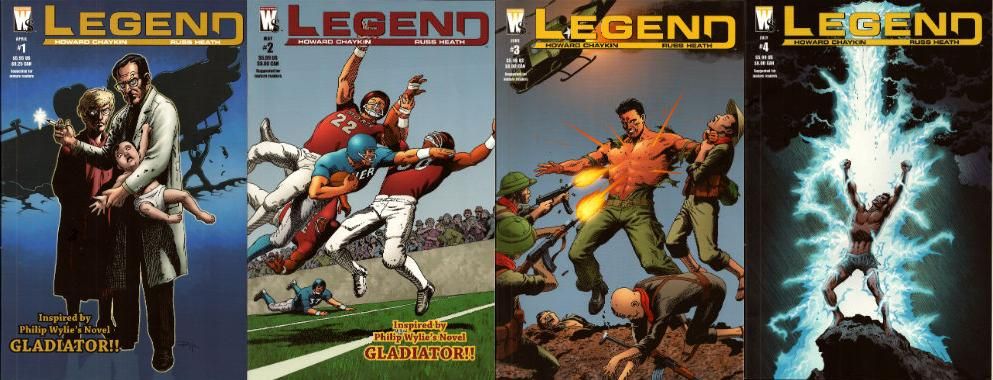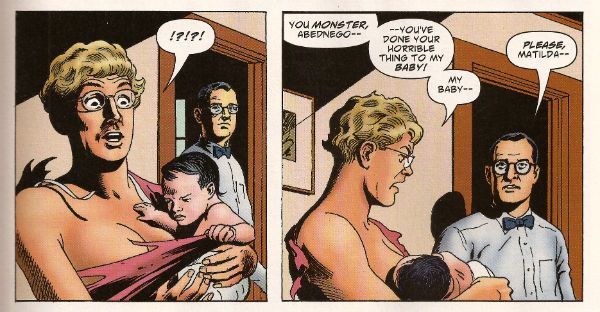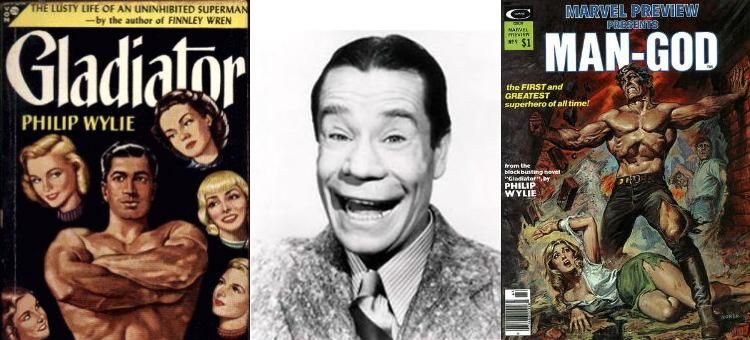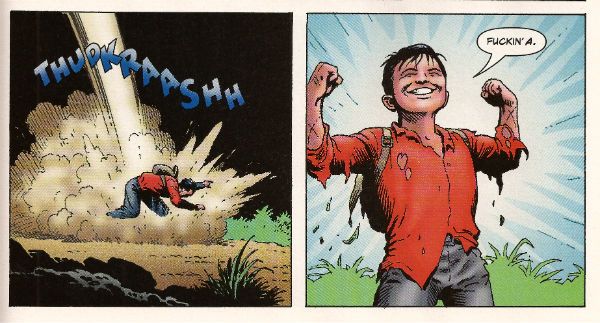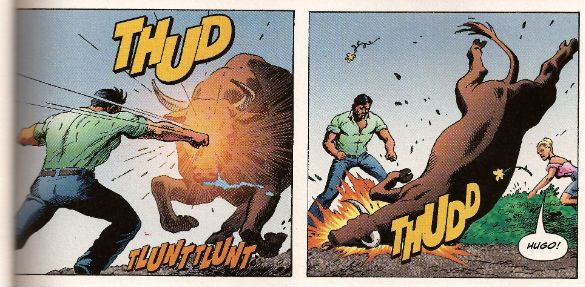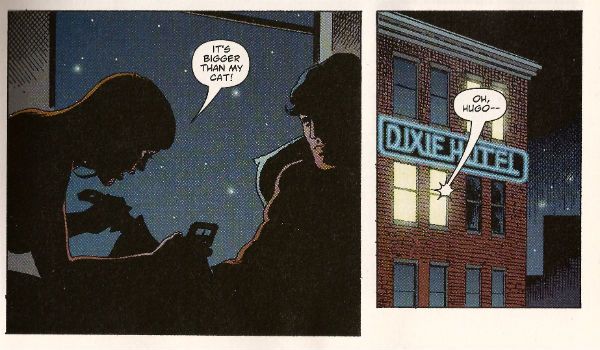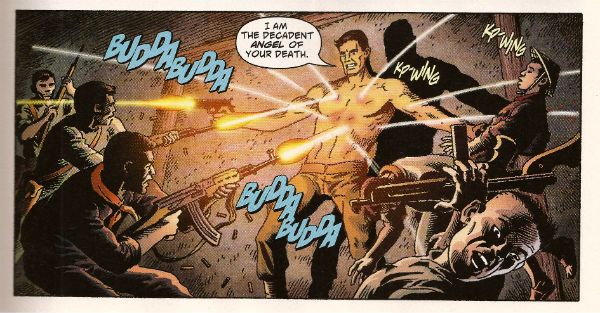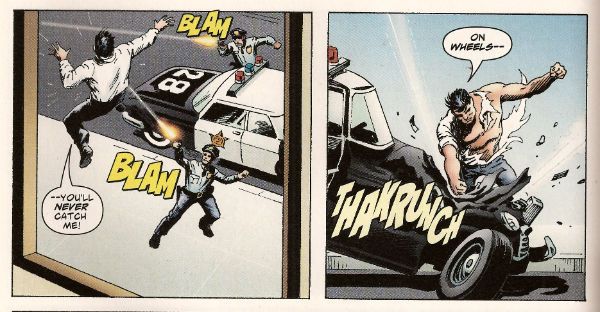"Anybody Who Expects GRATITUDE From A Cat Is A REAL Asshole..." COMICS! Sometimes It Might Just Be A Beautifully Illustrated Black Joke At The Expense of Catholicism!
/During 1990-91 DC Comics published one of the finest comics ever created. Its sales did not set the world afire. In December 2014 you get the chance to put things right. In December 2014 DC Comics are publishing, for the first time ever, the collected TWILIGHT by Howard Victor Chaykin, José Luis García-López, Ken (Kenneth) Bruzenak, Steve Oliff and Richard Ory. I like it and I think you will too. (Now UPDATED to include quotes and acknowledgements.)
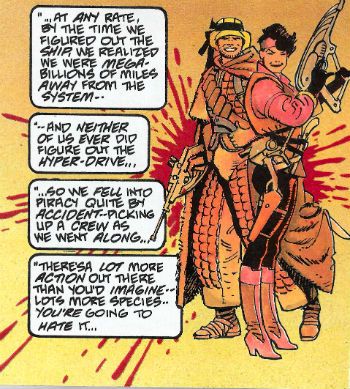 From TWILIGHT by Chaykin, Garcia-Lopez, Bruzenak, Oliff & Ory
From TWILIGHT by Chaykin, Garcia-Lopez, Bruzenak, Oliff & Ory
Anyway, this… Acknowledgement: The words which follow are enormously indebted to the work of Brannon Costello whose Howard Chaykin: Conversations (2011, University of Mississippi Press) remains the go-to book for HVC reference. A house without a copy is an empty house.
TWILIGHT #1 to 3 Artist - José Luis García-López Writer - Howard Victor Chaykin Colour Artist - Steve Oliff Letterer - Ken (Kenneth) Bruzenak Backgrounds - Richard Ory DC Comics, $4.95ea (1990-91) Tommy Tomorrow created by Virgil Finlay, Howard Sherman, Bernie Breslauer, George Kashdan & Jack Schiff Star Rovers created by Sid Greene & Gardner Fox Star Hawkins created by Mike Sekowsky & John Broome Space Ranger created by Bob Brown, Gardner Fox & Edmond Hamilton Manhunter 2070 created by Mike Sekowsky Space Cabbie created by Howard Sherman & Otto Binder Knights of the Galaxy created by Carmine Infantino & Robert Kanigher
From TWILIGHT by Chaykin, Garcia-Lopez, Bruzenak, Oliff & Ory
"It takes all of DC's really stupid-ass science fiction characters in the '50s and '60s, except for Adam Strange, and coordinates them into a cohesive and self-supporting universe....These characters were very important to me as a kid." Howard Victor Chaykin in Amazing Heroes #132, January 1988. Taken from p.105 of Howard Chaykin: Conversations edited by Brannon Costello, 2011, University of Mississippi.
TWILIGHT was a three issue series originally published by DC in the prestige format during 1990-91. TWILIGHT is the story of a bunch of people who all get what they want and it ends up doing none of them any favours whatsoever. The bunch of people in question are mainly rejigged DC sci-fi characters who had lain mostly fallow since the ‘50s and ‘60s. Tommy Tomorrow, Star Hawkins, Manhunter 2070, Space Cabbie, etc. Even Chaykin’s own Ironwolf appears briefly, and his ridiculous wooden space ship proves pivotal to events. (If Adam Strange seems conspicuous by his absence; Richard Bruning had first dibs there). There are plenty of new characters but the gist of the thing was that these were yesterday’s characters of tomorrow, today. Oh, you know what I mean.
From TWILIGHT by Chaykin, Garcia-Lopez, Bruzenak, Oliff & Ory
"Homer Glint is Ned Buntline. The tagline of the material is, "You read these stories as a boy, now you're ready for the truth!" Howard Victor Chaykin in Comics Interview, November 1989. Taken from p.143 of Howard Chaykin: Conversations edited by Brannon Costello, 2011, University of Mississippi.
Howard Victor Chaykin’s cute conceit was that the old timeycomics were like the sci-fi version of Ned Buntline pulps; the ones which invented the sanitised Wild West we all prefer to the filthy and psychotic reality. Homer Glint narrates here as a sort of space Buntline setting the record straight in his twilight (Ho! Ho!) years. TWILIGHT, then, is what really happened as opposed to what you were told happened in fusty old code approved DC sci-fi Comics. TWILIGHT, then, is the real Wild West where Trigger bit Roy Rogers’ face off and Gabby Hayes was scalped and staked out for fire ants. But, y’know, in space. I think it would be fair to say that the audience familiar with these characters reacted badly to TWILIGHT. Which is weird, because Howard Victor Chaykin clearly loves these characters. The problem is that Howard Victor Chaykin loves these characters enough to imbue them with a lively fire more appropriate to the times he was writing in. No, that’s not the problem; the problem, and I’m just guessing here, is that comics fans think that embalming the characters they like at the point they met them is love. I sincerely hope they do not carry this attitude over to their dealings with real people. With TWILIGHT Howard Victor Chaykin sought to bring DC’s characters of the future into the present but it turned out the fans preferred them in the past. It’s a good job Howard Victor Chaykin likes irony.
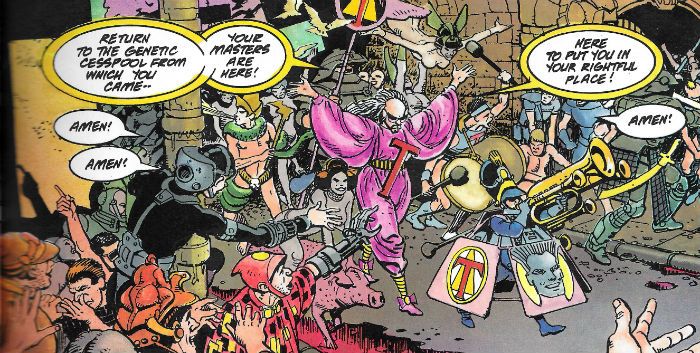 From TWILIGHT by Chaykin, Garcia-Lopez, Bruzenak, Oliff & Ory
From TWILIGHT by Chaykin, Garcia-Lopez, Bruzenak, Oliff & Ory
"...it's the story of the introduction of immortality into the human eco system and how it destroys stuff." Howard Victor Chaykin in Amazing Heroes #132, January 1988. Taken from p.105 of Howard Chaykin: Conversations edited by Brannon Costello, 2011, University of Mississippi.
Like most folk who were awake during the 20th Century Howard Victor Chaykin seems to have come to the conclusion that in the end Humanity will do the right thing, but only after it has spent an impressive amount of time trying the wrong thing out first. When the book opens humanity has been playing God for so long that it has not only turned animals into an underclass but robots as well. Even in the future we’ll need someone to shit on, even if we have to build them. The next step, naturally, is to become Gods and, via a series of repellent occurrences, Godhood is attained by two characters, while everyone else gets the leftovers in the form of Immortality. TWILIGHT doesn’t shift from the tradition of short shrift accorded Immortality by fantastic fiction. Read enough of that stuff and it’s like there’s an unconscious realisation that Humanity just isn’t built for the long haul. Immortality is the gift Humanity’s always eager to receive but probably isn’t ready for; like an 8 year old with The Terminator on his Christmas list (no chance, “Gil”). TWILIGHT has an admirably simple premise: what if Humanity got everything religion promised. What if all those poetic allusions to greater truths manifested as day to day reality? Only good things! No, not really. Because no matter the level of progress, unless basic human nature changes we’re always going to struggle with it. TWILIGHT is about that struggle because, all else aside, TWILIGHT is about people.
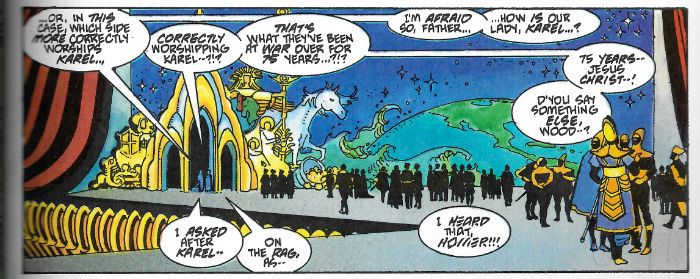 From TWILIGHT by Chaykin, Garcia-Lopez, Bruzenak, Oliff & Ory
From TWILIGHT by Chaykin, Garcia-Lopez, Bruzenak, Oliff & Ory
"Tommy Tomorrow starts out as the character Peter O'Toole played in The Ruling Class and becomes The Antichrist..." Howard Victor Chaykin in Comics Interview #5, November 1989. Taken from p.143 of Howard Chaykin: Conversations edited by Brannon Costello, 2011, University of Mississippi.
As in life, so in TWILIGHT; people are complicated. Like many a long haul comics reader I’d been brought up to understand the hero was who the book was named after so I was a bit lost on the first pass. After all, there’s no one in the book called Terry Twilight. There is someone called Tommy Tomorrow in it, but he’s just simply awful, poppets. And so is everyone else. There are degrees of awful though. There’s a difference between being awful because you’re a prudish killjoy and being awful because you are a debauched genocidal maniac. Impressively in TWILIGHT there are actually more ways of being awful than there are characters because some of these folk are just rife with foibles . And, because of the plot, these folk can live a long ass time so their kinks work on their better natures like rain on cathedrals. Take John Starker, he starts off awful because he’s so busy trying to hump automata that he neglects his duty and people die. Now that’s awful but it’s within genre comics’ flawed-but-redeemable boundaries. But in short order he’s so consumed by his unrequited passion for a Katy Perry looking clanker (before Katy Perry was a thing, even; Howard Victor Chaykin – prescience personified!) he’s just straight up shooting people against the wall of a church. I mean, they’ve asked him to (Immortality isn’t for everyone; they get wicked bored) and, sure, he can’t look while he does it, but still and all. Shooting people against the wall of a church? Not a healthy use of one’s time, I’m thinking. Oh yeah, and he’s one of The Good Guys. You want feet of clay, sophisticated characterisation and those shades of gray (all 50, ‘mIright, ladies!)? Howard Victor Chaykin was hosing the place down with all that stuff in 1990. And ,boy, did Space Cabbie fans not want that in 1990. Apparently it’s all anyone wants in 2014 so I’m expecting big things from the comic audience this time out. It's the usual bawdy and raucous writing performance from Howard Victor Chaykin and if it leans a little heavily on synchronicity, well, he's built an out in this time; because that's how the Gods work, bubeleh!
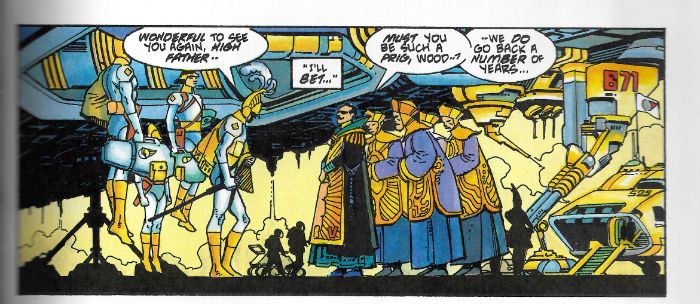 From TWILIGHT by Chaykin, Garcia-Lopez, Bruzenak, Oliff & Ory
From TWILIGHT by Chaykin, Garcia-Lopez, Bruzenak, Oliff & Ory
"The artwork is coming in like I could never have imagined; it's far and away the best thing that Garcia-Lopez has ever done. I'm flattered by the work, quite frankly." Howard Victor Chaykin in Comics Interview #75, November 1989. Taken from p.143 of Howard Chaykin: Conversations edited by Brannon Costello, 2011, University of Mississippi.
TWILIGHT is illustrated in the main by José Luis García-López. Now, the big thing about José Luis García-López is not how many names he has but how ridiculously good he is at this comic book art lark. You know that thing you sometimes do where your eyes glaze over and you kind of stop registering the art and just take in the words? I’ve never done that with a José Luis García-López comic. Even when Elvis sang some cack handed doggerel you paid attention! Similarly, even when José Luis García-López was drawing some random issue of DC COMICS PRESENTS you were aware of a level of artistry out of all proportion to the subject matter. But he isn’t drawing DC COMICS PRESENTS here. No, José Luis García-López is drawing TWILIGHT. In TWILIGHT José Luis García-López is either working off breakdowns by Howard Victor Chaykin or is so sympatico to his taskmaster’s method that it’s as though he is channelling the Chaykin on every page. And, hoo ha, does Chaykin make José Luis García-López sing for his supper! TWILIGHT places ridiculous demands on its artist who is required to bring the same level of visual zip to a double page spread of dusty campaign insignias as he is to a double page spread of an ad-hoc satellite composed of Communistic accretions. Sing, José Luis García-López! SING! TWILIGHT takes place on a canvas as big as the universe and homes in on events as small as a cat stalking a bird. Sing José Luis García-López . SING! TWILIGHT requires José Luis García-López to trap a space armada, a rioting crowd or an explosive ascension within the same amount of space as a pipe smoking ape’s face. Sing José Luis García-López! SING! And José Luis García-López SINGS his little heart out. There’s a fucking artistic aria on every page of TWILIGHT, people. In 1990 no one bought it; no one cared! If TWILIGHT wasn’t written so damn well it’d still be worth looking at because José Luis García-López’s work is always worth looking at. I don’t want to overstate it but I feel privileged to have lived to see José Luis García-López’s art. I can’t afford those Artists Editions they do for the well-heeled comic fan but if they did an Artist’s Edition of TWILIGHT I’d find a way to afford it.
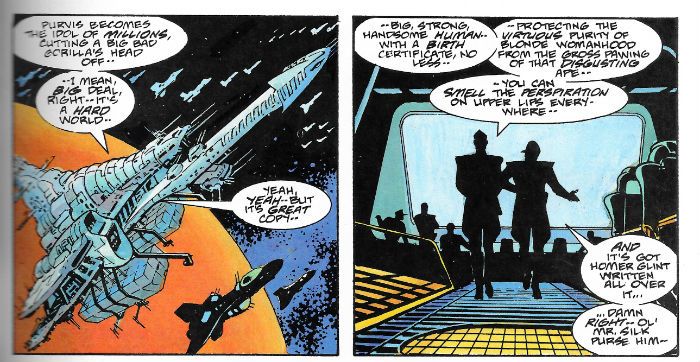 From TWILIGHT by Chaykin, Garcia-Lopez, Bruzenak, Oliff & Ory
From TWILIGHT by Chaykin, Garcia-Lopez, Bruzenak, Oliff & Ory
But, fair’s fair, the magnificent visuals of TWILIGHT aren’t solely due to José Luis García-López. There’s Ken (Kenneth) Bruzenak whose lettering always elevates the pages it graces (and if the pages it graces are by José Luis García-López, well, homina, homina, homina!) He doesn’t get off easy either, Howard Victor Chaykin doesn’t play favourites; Ken Bruzenak has to sweat for his pennies too. One character who has experienced a form of ascension talks in a different language and The Bruise has to come up with a font which suggests this, while still being perfectly legible. (SPOILER: he succeeds). Then there are the bits where Tommy Tomorrow is so consumed by his own self-love that he starts bellowing his own name in the form of his old comic book logo, or certain words are transcribed in the form of hot pink neon lettering… and that’s just the pages I flicked past while refreshing my memory. Throughout TWILIGHT the speech bubbles flare with the emotional freight of the words they contain, SFX enhance the atmosphere or heighten the illusion of chaos without ever overloading or crowding even the smallest of spaces in which Ken Bruzenak’s artistry is confined.
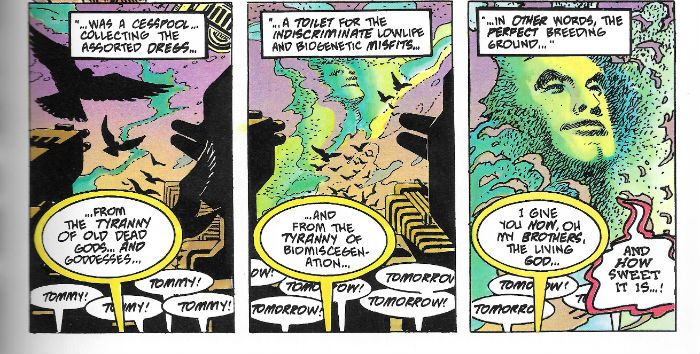 From TWILIGHT by Chaykin, Garcia-Lopez, Bruzenak, Oliff & Ory
From TWILIGHT by Chaykin, Garcia-Lopez, Bruzenak, Oliff & Ory
I am hopeless on colouring but I know for a fact that Steve Oliff worked his tuchas off on TWILIGHT too. I know that because it looks to my old eyes as though he’s used his "blue-line"(?) method; the one I recall from BLACKHAWK: BLOOD AND THUNDER (Chaykin, Bruzenak, Oliff & Ory. Uncollected) and TIME2 (ditto). And if I understood it correctly that seemed like a ridiculously time and effort intensive method of funnybook colouring. You could probably do all that with computers in a twentieth of the time now, I guess. It’s kind of staggering someone would go to those Herculean lengths back in 1990. But Steve Oliff did and TWILIGHT’s certainly worthy of his efforts. Given it was 1990 it’s possible that as lovely as they are Oliff’s colours were probably short changed by the printing methods of the time. So, I have high hopes for the collection; namely that DC haven’t just got an intern to photocopy the old comics and that Oliff’s colours will benefit from advances in production and will impress anew.
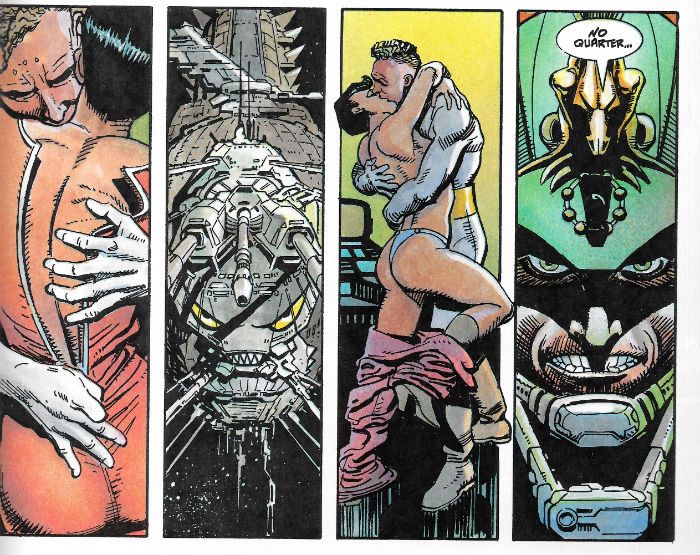 From TWILIGHT by Chaykin, Garcia-Lopez, Bruzenak, Oliff & Ory
From TWILIGHT by Chaykin, Garcia-Lopez, Bruzenak, Oliff & Ory
Richard Ory’s name doesn’t appear on this comic but I understand he did the backgrounds for José Luis García-López. I got no beef with the backgrounds so high fives for Richard Ory, holding his own in such esteemed company is nothing to be sneezed at. Yeah, that’s right I even went and found out the background guy’s name; I have done my due diligence because TWILIGHT is worthy of it. Every hand involved in the pages of TWILIGHT deserves their portion of praise. For I lied earlier; it’s not an aria on every page; it’s a choir. A choir composed of Howard Victor Chaykin, José Luis García-López, Ken (Kenneth) Bruzenak and Steve Oliff.
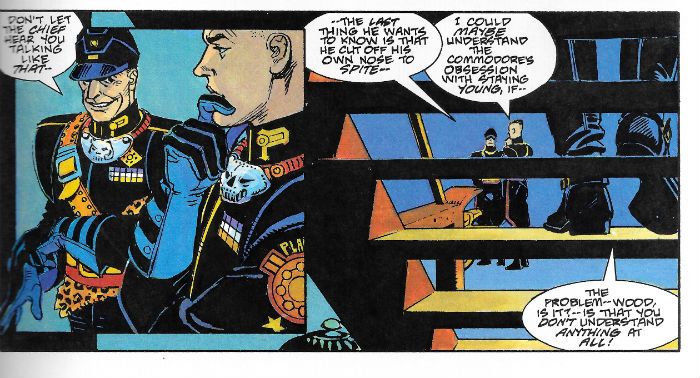 From TWILIGHT by Chaykin, Garcia-Lopez, Bruzenak, Oliff & Ory
From TWILIGHT by Chaykin, Garcia-Lopez, Bruzenak, Oliff & Ory
"I'd like to see Twilight back in print." Howard Victor Chaykin in Comic Book Artist Vol.2 #5, December 2006. Taken from p.239 of Howard Chaykin: Conversations edited by Brannon Costello, 2011, University of Mississippi.
It’s now 2014 so all the Space Cabbie fans have probably died off and everybody else could give a rusty tin shit about Tommy Tomorrow so, hopefully, TWILIGHT’s reception will be a little warmer this time out. Twenty fours year on and I remain adamant in my belief that TWILIGHT by Howard Victor Chaykin, José Luis García-López, Ken (Kenneth) Bruzenak, Steve Oliff and Richard Ory is EXCELLENT!
Sometimes we cook 'em in the oven of our Love for twenty four years - COMICS!!!!
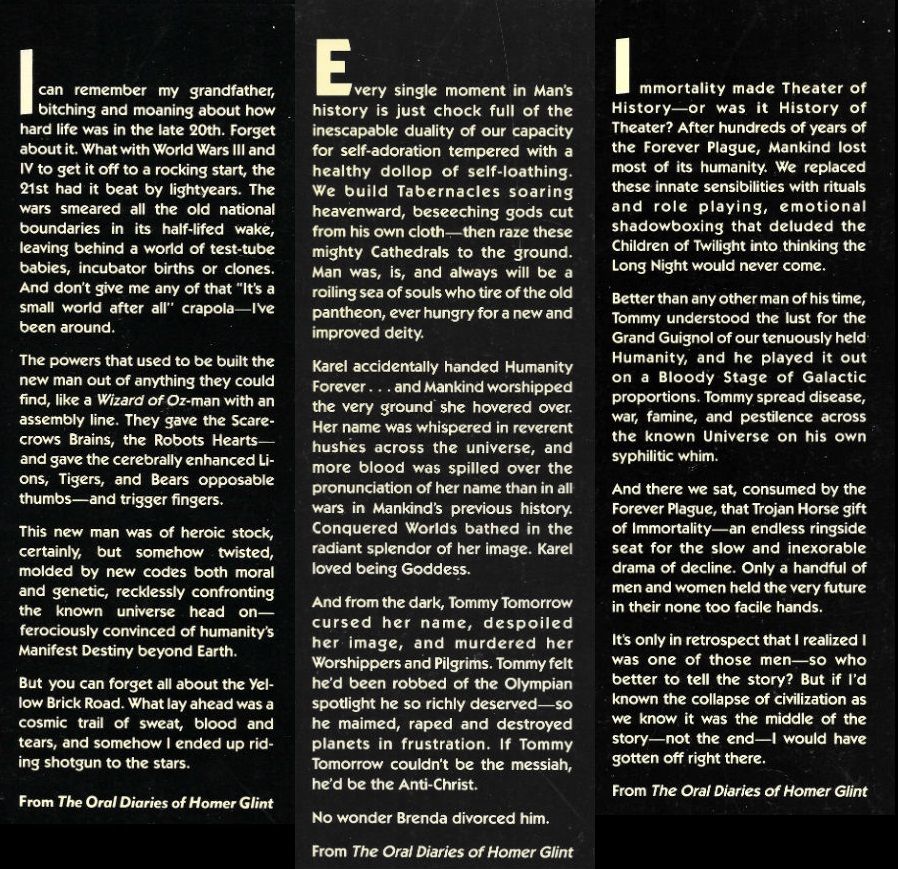 From TWILIGHT by Chaykin, Garcia-Lopez, Bruzenak, Oliff & Ory
From TWILIGHT by Chaykin, Garcia-Lopez, Bruzenak, Oliff & Ory


